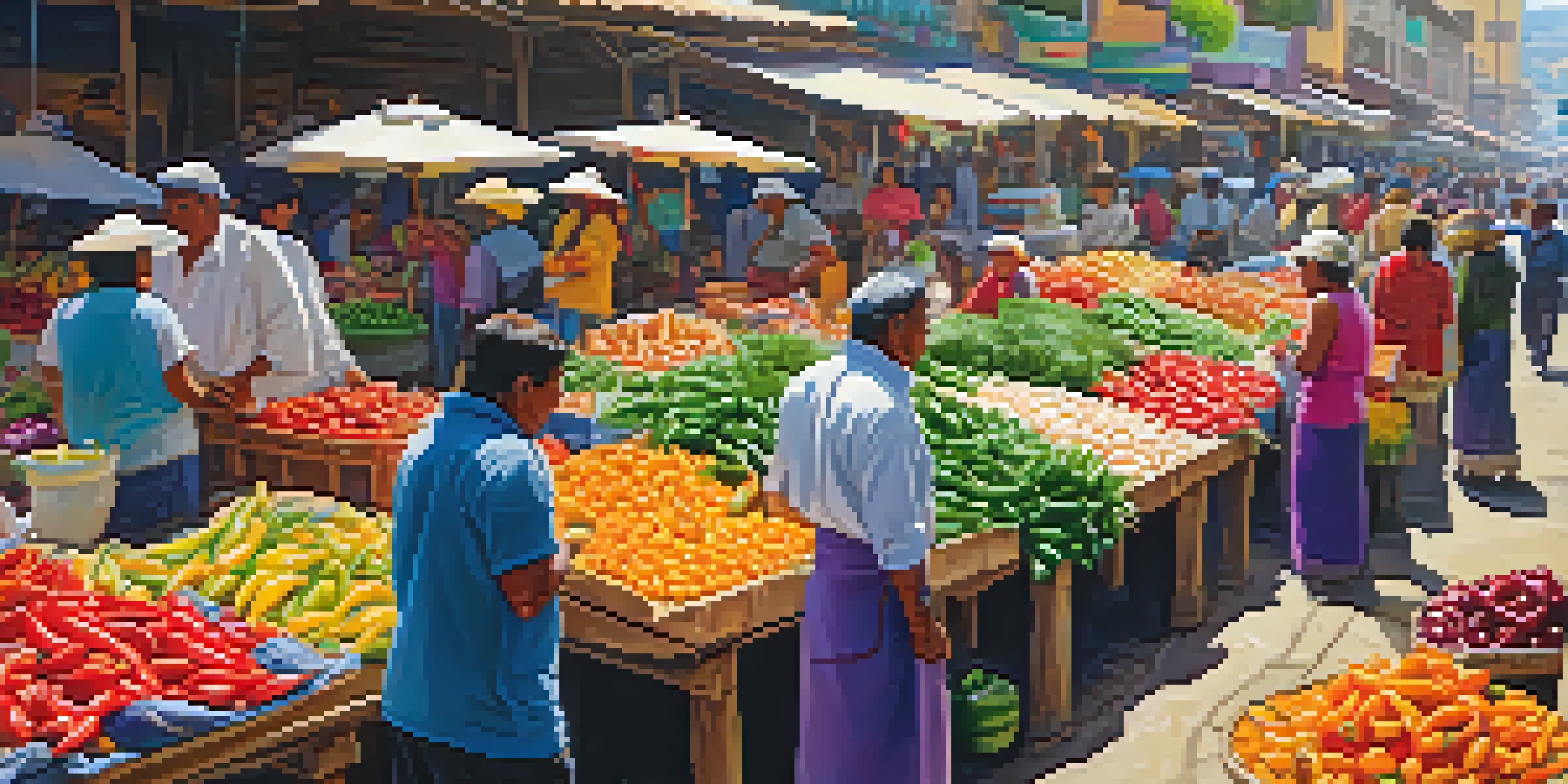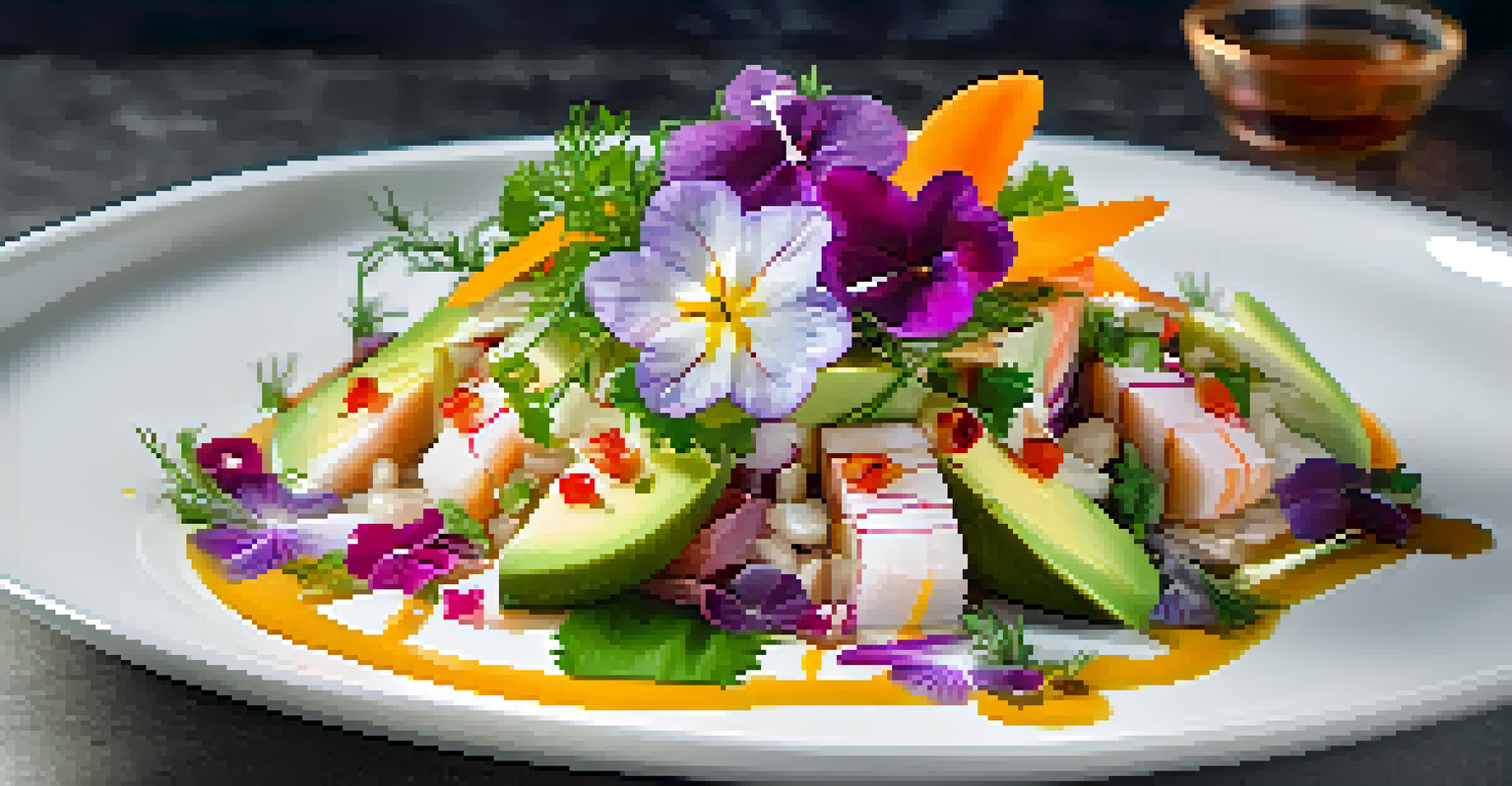The Influence of Peruvian Cuisine on Asian Food Culture

Understanding the Roots of Peruvian Cuisine
Peruvian cuisine is a vibrant tapestry woven from diverse cultural influences, primarily indigenous, Spanish, African, and Asian. This rich history has not only shaped its unique dishes but also created a culinary platform that resonates with global flavors. At the heart of this cuisine lies an emphasis on fresh ingredients and bold flavors, making it appealing to food lovers everywhere.
Food is our common ground, a universal experience.
The fusion of these cultures can be seen in staples like ceviche, which showcases Peru's coastal resources, and the use of aji peppers, which add depth and heat. The blend of ingredients and techniques from different cultures has made Peruvian cuisine a melting pot of flavors, setting the stage for its influence on other culinary traditions.
As Peru has opened its doors to the world, its culinary scene has become a beacon of innovation, inspiring chefs and food enthusiasts alike. This global attention has sparked a curiosity about how its flavors can meld with other cuisines, particularly those in Asia, creating a delicious cultural exchange.
The Arrival of Asian Immigrants in Peru
Asian immigration to Peru began in the 19th century with the arrival of Chinese and Japanese workers, who brought their culinary traditions along. These immigrants settled in Peru, contributing to the local food landscape and intermingling their flavors with traditional Peruvian ingredients. This blending gave rise to unique dishes that reflect both Asian and Peruvian heritage.

One notable example is 'Chifa,' a popular fusion of Chinese and Peruvian flavors, characterized by stir-fried rice dishes that incorporate local ingredients like aji and chicken. Chifa restaurants became commonplace in Lima, showcasing how Asian cooking techniques can harmonize with Peruvian tastes to create something entirely new.
Peruvian Cuisine's Cultural Fusion
Peruvian cuisine is a vibrant blend of indigenous, Spanish, African, and Asian influences, creating a unique culinary landscape.
The influence of Japanese cuisine is also significant, particularly in the preparation of seafood. Techniques such as sushi-making have been adapted using local fish and spices, enhancing the overall flavor profile while retaining a distinct Peruvian flair.
Ceviche and Its Asian Connections
Ceviche, often regarded as the national dish of Peru, has drawn parallels with Asian dishes like sashimi and poke, highlighting a shared appreciation for fresh seafood. The fundamental similarity lies in the focus on raw ingredients and the delicate balance of flavors. Both culinary traditions emphasize freshness, which is crucial for achieving optimal taste.
Cuisine is the ultimate form of cultural exchange.
In recent years, chefs have begun to experiment with ceviche by incorporating Asian elements, such as soy sauce and sesame oil, to enhance the marinade. This innovative approach not only pays homage to its roots but also introduces a new layer of complexity that appeals to a broader audience.
The evolution of ceviche reflects a growing trend within the culinary world, where traditional dishes are reimagined through the lens of different cultures. As a result, ceviche has gained international recognition and has become a symbol of the harmonious blend between Peruvian and Asian cuisine.
Peruvian Ingredients in Asian Cooking
Peruvian ingredients like aji peppers, quinoa, and purple corn have begun to make their way into Asian kitchens, enriching the flavors of traditional dishes. Chefs in Asia are increasingly experimenting with these ingredients to create innovative fusion dishes that celebrate both culinary worlds. This cross-pollination enriches the dining experience, offering a fresh take on familiar flavors.
For instance, aji amarillo, a vibrant yellow pepper, is being used in stir-fries and sauces, adding a distinct heat and flavor that complements various Asian cuisines. Similarly, quinoa, known for its nutritional benefits, is being incorporated into sushi rolls and salads, showcasing its versatility.
Asian Techniques Enhance Peruvian Dishes
Asian cooking methods like stir-frying and steaming are increasingly being adopted in Peruvian kitchens, resulting in lighter, flavorful dishes.
This trend not only highlights the adaptability of Peruvian ingredients but also encourages a dialogue between cultures through food. As these ingredients gain popularity, they foster a greater understanding and appreciation of the culinary roots they originate from.
Asian Culinary Techniques in Peruvian Cooking
In addition to ingredients, Asian cooking techniques have also found their way into Peruvian kitchens. Techniques such as stir-frying and steaming are being embraced by chefs who aim to create lighter versions of traditional dishes. This blending of methods allows for a new approach to cooking that enhances flavor while maintaining health-conscious practices.
For example, the use of steaming in the preparation of traditional Peruvian tamales has led to a softer texture while preserving the vibrant flavors of the fillings. This technique not only elevates the dish but also showcases how culinary techniques can transcend cultural boundaries.
As chefs continue to explore this fusion of techniques, they're not just creating new dishes, but also fostering a deeper appreciation for the culinary arts as a whole. This cross-cultural exploration enriches the dining landscape, making it more dynamic and exciting.
Fusion Restaurants: A Culinary Trend
The rise of fusion restaurants is a testament to the growing popularity of Peruvian-Asian cuisine. These establishments creatively blend elements from both cultures, resulting in unique dining experiences that attract food enthusiasts eager to try something different. The vibrant atmosphere of these restaurants often reflects the lively spirit of both cultures, making them a go-to destination for adventurous eaters.
Dishes like sushi topped with ceviche or dim sum filled with Peruvian flavors are just a couple of examples of how chefs are pushing the boundaries of traditional cuisine. This willingness to experiment and innovate has turned these fusion restaurants into culinary hotspots, sparking a trend that is capturing the attention of food lovers worldwide.
Fusion Restaurants Drive Culinary Trends
The rise of fusion restaurants showcases innovative blends of Peruvian and Asian cuisines, captivating food enthusiasts worldwide.
As diners seek out new flavors and experiences, the demand for such fusion culinary concepts continues to grow. This trend not only highlights the adaptability of both cuisines but also signifies a broader movement towards global culinary exploration.
Culinary Exchange: A Global Phenomenon
The influence of Peruvian cuisine on Asian food culture is part of a larger trend of culinary exchange happening around the globe. As cultures continue to interact and share their traditions, the food we eat evolves, reflecting a tapestry of flavors and techniques. This phenomenon is particularly evident in urban centers where diverse populations come together, fostering an environment ripe for culinary innovation.
Social media has played a pivotal role in this exchange, allowing chefs and home cooks to share their creations and inspire others. Platforms like Instagram and TikTok have made it easier than ever for food trends to spread quickly across borders, further promoting the blending of culinary traditions.

Ultimately, this global culinary exchange enriches our understanding of food and culture. It encourages a celebration of diversity while highlighting the common threads that connect us, reminding us that food is not just sustenance, but a bridge between cultures.